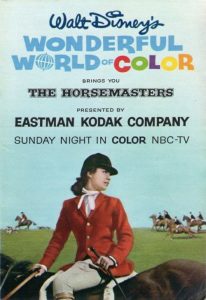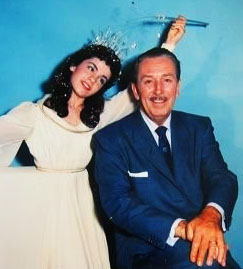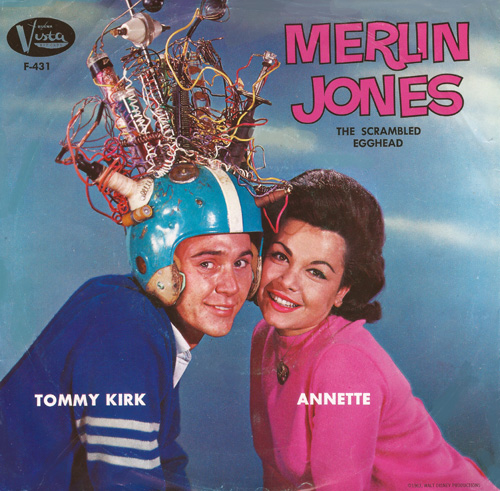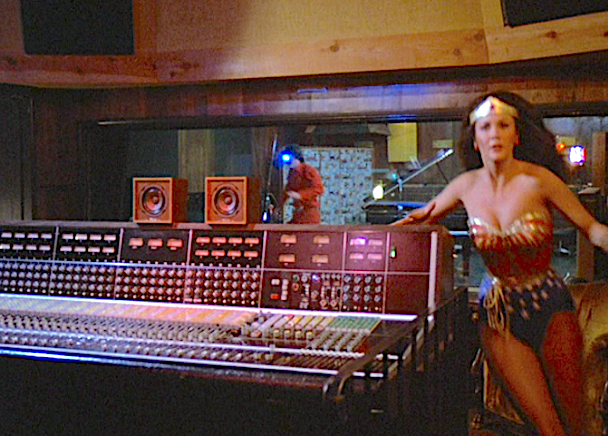More about the animated side of Annette Funicello’s musical legacy, including the stop-motion titles in the original Parent Trap and what her success helped make possible.

TOMMY SANDS AND ANNETTE
Sing the Title Song from
Walt Disney’s THE PARENT TRAP
also “Let’s Get Together”
Buena Vista Records F-802 (45 RPM 7” Mono)
Also available on the album THE PARENT TRAP Buena Vista BV/STER-3109 (33 RPM 12” LP)
Songs and album available on Amazon and iTunes
Released in May 1962 (Album released in June 1961). Executive Producer: Jimmy Johnson. Music/Lyrics: Richard M. Sherman, Robert B. Sherman. Musical Director/Producer: Camarata. Recorded at Sunset Sound, Hollywood.
Dynamic graphics and animated title sequences were a welcome sight in sixties and seventies films and TV shows. Artists like Saul Bass raised it to a fine art. DePatie-Freleng, in addition to its Warner Brothers character work, built a foundation with the 1963 Pink Panther main title animation, proving so successful that it became its own series. Even Hanna and Barbera, while at MGM in 1952, provided experimental TV ads for two features, Pat and Mike starring Spencer Tracy and Katharine Hepburn, and Scaramouche with Stewart Granger):
Walt Disney and his team contributed to the trend by eschewing static (though lovely) title images for clever animated gags at the beginning of 101 Dalmatians and whimsical stop-motion titles for The Shaggy Dog, a box office smash that offered Annette a small, non-singing role, her first in a theatrical film. The “found object” stop-motion in The Shaggy Dog (by T. Hee, X Atencio and Bill Justice) was an offshoot of the technique used in the Oscar-winning Noah’s Ark, explored in this Animation Spin.
Members of this small group, particularly Atencio and Justice, continued working with stop-motion for various projects, most notably the titles for the enduring 1961 Hayley Mills comedy The Parent Trap. This time, doll-like animation figures with movable armatures were manipulated in the manner that Rankin/Bass would make popular in TV specials for the next several decades.
An NBC Wonderful World of Color half-hour TV episode was devoted to the production of The Parent Trap animated titles and the recording of the song. Last week’s Spin feature about Babes in Toyland was a factor in the duet of Annette and Tommy Sands as both films overlapped in production.
Like Babes in Toyland, The Parent Trap played a more role in the long-range development of the Disney organization beyond its identity as filmed entertainment. Most Disney enthusiasts know the story about the Sherman Brothers, first considered relative obscure “rock and roll songwriters” until Annette’s records began to hit the top ten and help Disney’s fledgling in-house record company stay afloat.
 The Horsemasters, a two-part Wonderful World of Color program and European theatrical release, required an Annette song.
The Horsemasters, a two-part Wonderful World of Color program and European theatrical release, required an Annette song.
Disneyland/Buena Vista Records President Jimmy Johnson brought the nervous brothers before Walt to get the song approved. Instead of talking about The Horsemasters, Walt described the plot of The Parent Trap in detail. Reminded about The Horsemasters, he quickly approved the “Strummin’ Song” (the sheet music for which sits on his piano in the formal section of his office). Johnson suggested the Shermans write songs for The Parent Trap. The strength of their songs and their keen sense of story impressed Walt so much that he had them added to the studio staff.
Richard Sherman often said, “Annette was our good luck charm.” It wasn’t long before the brothers were working on Mary Poppins in addition to an avalanche of films, TV shows and attractions. It would be difficult to deny that the music The Shermans created for Poppins was a key factor in it becoming the biggest film success in Walt Disney’s lifetime, as well as a bonanza for nearly every division of his company.
Like the magic carpet bag, Mary Poppins’ profits kept on giving. Poppins box office profits were invested in the Florida land that would become Walt Disney World Resort. A new company was formed called “MAPO” to construct much of that resort, also from Poppins capital. It all began with Annette, the Queen of Walt Disney World.

“The Parent Trap” Single Version – Tommy Sands and Annette
Note the difference between the vinyl version of the title song and the way it is done in main title of the film. The soundtrack arrangement was made to accommodate the length of the credits and animation, while the single was designed for home listening and radio play. However, while Camarata receives no film credit, he likely produced and/or arranged the soundtrack version as well. There is an obvious edit (and a momentary pause) between Paul Smith’s introductory music and the switch to a rhythmic pop sound much like the record. Camarata did the vocal arrangements for Summer Magic (for which he did receive a screen credit) but he probably also produced these vocals The Parent Trap, as well as the titles for The Three Lives of Thomasina (which featured the singing of Disneyland Story Reader Robie Lester singing as well as speaking Karen Dotrice’s first line: “Thomasina!”).
Tutti Camarata, from all accounts, wasn’t much to care about self-aggrandization. It was about the music, the records, the talent and the people.

MERLIN JONES, THE SCRAMBLED EGGHEAD
ANNETTE AND THE WELLINGTONS
Buena Vista Records F-431 (45 RPM 7” Mono)
Also available on the album ANNETTE: MUSCLE BEACH PARTY Buena Vista BV/STER-3314 (33 RPM 12” LP)
Songs and album available on Amazon and iTunes
Released in December 1963 (Album released in April 1964). Executive Producer: Jimmy Johnson. Music/Lyrics: Richard M. Sherman, Robert B. Sherman. Musical Director/Producer: Camarata. Recorded at Sunset Sound, Hollywood.
Not long before the release of The Misadventures of Merlin Jones, the Oscar-nominated Symposium on Popular Songs was released. The 1962 featurette segments combine the stop-motion methods used in Disney main titles as well as Noah’s Ark, framed by a cel-animated commentary by Ludwig Von Drake. (It became a marvelous, currently available album called Tinpanorama which is discussed in this Spin.)
The paper cutout technique for The Misadventures of Merlin Jones features a wide-eyed cartoon version of Annette. It bears a similarity to all but the first stop-motion sequence in Symposium. It even uses some of the same props, such as the saxophone from “Puppy Love is Here to Stay.”
After Merlin Jones, there wouldn’t be much stop-motion in Disney films on any major theatrical scale until Tim Burton’s The Nightmare Before Christmas (preceded only by Burton’s rarely screened stop-mo short Vincent) – save for some Monty Python-like imagery in Ward Kimball’s It’s Tough to Be a Bird (1969) and Dad, Can I Borrow the Car?
By 1965, Walt Disney brought Justice and Atencio to WED Enterprises were they became Imagineers, transitioning from a world of stop-motion figures, paper cutouts and oversized toys to the dawn of Audio-Animatronics, creating attractions that are still considering among the world’s greatest (and most profitable as extended IP for spinoff films and merchandise).

This beautiful recreation of the Annette animated cut-out was created by Disney artist Kevin Kidney
Merlin Jones would mark the only time Disney presented Annette as an animated character—and in stop-motion rather than cel animation–though she was often seen in illustrations for books and assorted merchandise. The film itself was a frothy, two-part situation comedy that generated a comic book, a Whitman hardcover junior novel and a huge amount of money at the box office.
For the Merlin single, Annette sings with The Wellingtons, a foursome signed by Walt Disney himself after a live appearance. They’re also known to Gilligan’s Island fans as the performers of the first-season theme song (recorded in show creator Sherwood Schwartz’s home). Some of them also appeared on the show as The Mosquitoes. The “B” side is called “The Scrambled Egghead,” a sort of spoken word version of the theme with Tommy Kirk and Annette, in their movie characters, discussing Merlin’s latest mind-reading invention.
Our own Jerry Beck has fond memories of seeing Annette and Tommy Kirk live and in person at a premiere event for The Misadventures of Merlin Jones in New York. “I got to meet each of them,” Jerry told me. “Tommy put on that crazy helmet with all the wires. I met him again years later and reminded him and he remembered—not about meeting me, I’m sure, but about the publicity tour. That helmet is such a wonderfully designed prop. You can tell it wasn’t just thrown together, but the wires were chosen by their colors and positioned to be funny. Sure, the movie was silly, but there was still a lot of skill and thought behind it, just like the helmet.”
Jerry also recalls a time he had asked songwriter Richard Sherman about Annette’s little lullaby, “I Can Fly”, heard in the Merlin Jones sequel, The Monkey’s Uncle. But Sherman had no actual memory of writing that song. The origins of that tune remained a mystery for years – becoming one of Disney’s “lost chords”. Disney composer and music historian Alex Rannie was also curious about that tune and researched it himself a few years ago – and graciously provided us with the answer: “Although it sounds very Sherman, it was actually written by Tom August (pen name of Alfred Lewis Levitt, along with Helen August (Helen Levitt), The Monkey’s Uncle screenwriter), lyrics, and Buddy Baker (who also did the score), music. (Levitt was blacklisted and used the pseudonym August when writing.)”
The Sherman brothers The Money’s Uncle title tune is probably better known than the film itself. It’s a quintessential Sherman “earworm” and is the only Disney song that the Beach Boys sang both on-camera and on Disney records with Annette (the credits were removed for the TV broadcast).
The recording used on the soundtrack is (yet again another uncredited) production by Camarata and recorded in his Sunset Sound Recorders “A” studio.

Clockwise from top left: Brian Wilson, Tutti Camarata, Annette, Robert Sherman, Richard Sherman, Al Jardine, Mike Love, Carl Wilson and Dennis Wilson.
If you saw the movie The Doors, above is the control room that Jim Morrison historically trashed (though it was recreated on a soundstage for the film). Below is the real control room as seen in a 1979 episode of Wonder Woman with Lynda Carter (and guest star Rick Springfield in the background) called “Amazon Hot Wax.”

As Leonard Maltin pointed out in his book, The Disney Films, the credits for Merlin Jones and The Monkey’s Uncle are remarkable in that they closely match those of Mary Poppins (even the choreographers), which resulted in Academy Awards for some of them. (They were on the lot, why not?) If these films seem astonishingly like unsold TV fantasy series pilots, keep in mind that The Shaggy Dog was pitched to ABC and was turned down.
When it was released to theaters instead, The Shaggy Dog made more money than Sleeping Beauty in the same year. That’s not a statement about public taste, or the relative quality of the two films, so much as it is a note in the timeline of pop culture and entertainment trends. Walt Disney was ahead of the curve, making hit fantasy comedies before television launched an entire wave of magical escapist series: My Favorite Martian, Bewitched, I Dream of Jeannie and so on. (Producer Irwin Allen also patterned his two most successful TV series, Voyage to the Bottom of the Sea–which began as a feature film–and Lost in Space, after two of Walt Disney’s most successful live-action features, 20,000 Leagues Under the Sea and Swiss Family Robinson.)
Still more Animation-ette! She also has a vinyl connection to classic Disney, as Disneyland Records’ first narrator of Snow White and the Seven Dwarfs. Check out this Spin for a look. Beyond Disney, Annette starred in a beach party movie with clay-animated main titles. 1965’s How to Stuff a Wild Bikini was one of two main titles Gumby creator Art Clokey animated for American-International Pictures.
Direct or not, intentional or circumstantial, Annette made a difference, even in her darkest hours. She established the Annette Funicello Foundation for Neurological Disorders. It is one of the non-profits that, at no extra charge, anyone can contribute when making any purchases through amazon smile. We miss her, but she still makes a difference. There’s also a keen new book honoring her by Rita Rose called Annette Funicello: Tributes from Fans and Friends.
“The Monkey’s Uncle” – Annette and The Beach Boys
It’s not in full stereo, but this vinyl version separates Annette, The Beach Boys and the music tracks into three parts, so it’s fun to hear it that way in addition to the way it is heard in the film. Once again, produced by Camarata and heard in the movie with no screen credit.
Special thanks to Stacia Martin, Hans Perk, Alex Rannie and Bill Morgan for their consultation on this article.


 GREG EHRBAR is a freelance writer/producer for television, advertising, books, theme parks and stage. Greg has worked on content for such studios as Disney, Warner and Universal, with some of Hollywood’s biggest stars. His numerous books include Mouse Tracks: The Story of Walt Disney Records (with Tim Hollis). Visit
GREG EHRBAR is a freelance writer/producer for television, advertising, books, theme parks and stage. Greg has worked on content for such studios as Disney, Warner and Universal, with some of Hollywood’s biggest stars. His numerous books include Mouse Tracks: The Story of Walt Disney Records (with Tim Hollis). Visit 





















































“I can’t stand it! This is terrible! How depressing…. Annette Funicello has grown up!” — Linus Van Pelt, 1965
I remember reading that comic strip as a small child and not getting the joke. Strange that I should have first encountered Annette’s name in the same place where I first learned about Beethoven and the Dead Sea Scrolls. Well, unlike Linus, I have no bad feelings about her growing up. I’m sure I’m not the only one who thought Annette looked better in the 1987 reunion movie “Back to the Beach” than she ever did in any of the AIP beach party movies of the sixties.
The Wellingtons! “Don’t Bug the Mosquitoes” is one of my favourite episodes of “Gilligan’s Island”. “Some of them also appeared on the show as The Mosquitoes….” Not some — all. There were only three of them, and the background singers in the Merlin Jones opening title are actually caricatures of the Wellingtons. That’s George Patterson on the left (who played Bango in the Mosquitoes), Kirby Johnson in the middle (who played Irving, with the bowler hat and sunglasses), and Ed Wade on the right (who played Bongo). Les Brown Jr., who played drummer Bingo, was not a member of the Wellingtons. He is the son of bandleader Les Brown, and Les Jr. has been leading his Band of Renown since his father retired in 2000.
The Wellingtons, as the Mosquitoes, played two of their own songs in that episode: “Don’t Bug Me” and “He’s a Loser”. About twenty years after “Gilligan’s Island” went off the air, on a whim Kirby Johnson called BMI and asked if those songs had earned any royalties from the show. They had — quite a substantial sum, in fact. The money had been accumulating over the years, but BMI didn’t know how to reach the band.
For the record, the vocal group that recorded the theme song for seasons 2 and 3 was The Eligibles. They recorded four singles for Capitol in the early sixties, but none of them charted.
Scaramouche! Scaramouche! Scaramouche! Scaramouche! Can you do the Fandango?
On a side note, the picture of Annette in a fairy princess costume posing with Walt is evidently a publicity still for promotion of “Rainbow Road to Oz,” in which Annette was cast as Princess Ozma. In her autobiography “A Dream is a Wish Your Heart Makes,” she devoted a couple of pages to the “Rainbow” project and shared her disappointment over its abandonment. She stated that she absolutely loved wearing that wig. Of course, as this post and the previous one have shown, Walt did not keep Annette idle after the cancellation of Oz.
It’s also interesting to note that the Disney film of “Babes in Toyland” came about just a handful of years after the Oz project ended (both of course prominently featuring Annette), proving that history repeats itself. The original stage version of “Babes” composed by Victor Herbert was created in imitation of the huge success of the original “Wizard of Oz” stage play of 1902!
And of course the Disney-Oz connection lived on through Disneyland Records, with several Oz-related albums being introduced over the next few years. More of the legacy left by Annette.
Clokey also did the credits for Dr. Goldfoot and the Bikini Machine. Not technically a Beach picture, but done by the same team, and Annette, Frankie and Harvey Lembeck (Erik Von Zipper) make cameo appearances.
I am very fond of these animated credit sequences — the MERLIN JONES credits are almost the highlight of the whole movie (which I like, but I’m being honest here). There is something somehow wonderful about the confluence of Annette and The Beach Boys at the opening of THE MONKEY’S UNCLE. Two American icons for the price of one!
But seeing the credits for MERLIN JONES and UNCLE reminded me of something. Back in 1997, the Writers Guild formally corrected the credits for both THE MISADVENTURES OF MERLIN JONES and THE MONKEY’S UNCLE to reflect the real names of their blacklisted writers.
Alfred Lewis Levitt, who co-authored the scripts for both MERLIN JONES and UNCLE with his wife Helen Levitt under the front names “Tom and Helen August,” spearheaded the effort to properly credit blacklistee writers for their work on numerous features produced between the late ’40s and early ’50s. In 1968, Levitt helped form the Hollywood Blacklist Writers Credits Committee; over the years, the committee worked to document and confirm the true authorship of the screenplays of dozens of movies written either entirely or in part by blacklisted writers. These films ranged from low-budget genre movies to Oscar-winning classics like ROMAN HOLIDAY, THE BRIDGE ON THE RIVER KWAI and LAWRENCE OF ARABIA.
The Writers Guild has strongly suggested (I suppose they can’t insist) that as these films are remastered or restored over time, the movies’ on-screen credits be corrected and amended to feature the real names of their screenwriters. This has been done in a number of cases (notably that of ROMAN HOLIDAY, KWAI, LAWRENCE and THE ROBE), and many would like to see this sort of correction continue.
Can’t Disney now properly credit the Levitts on prints of MERLIN JONES and THE MONKEY’S UNCLE? If Paramount, Columbia and Fox managed to figure out how to digitally correct the credits on their films, why can’t tech-savvy Disney?
” “I can’t stand it! This is terrible! How depressing…. Annette Funicello has grown up!” ”
My perspective back in the day was more like: “I can’t believe it! This is amazing! How intoxicating…. Annette Funicello has grown up!”
Agreed on the Back To The Beach evaluation.
Heck, she was a knockout in those dopey Skippy spots.
Sticking to animation, I quote (paraphrase) Homer Simpson: “Mmmmm… Annette… drrrrrooooollllllllll…”
I realize that Ehrbar’s posting is about the wonderful Annette Funicello, but in his discussion he included a link to the main title animation of the 1963 live-action film “Pink Panther.” If I may stray slightly from the primary topic, allow me to offer for your viewing pleasure all eleven animated opening title sequences of the “Pink Panther” film franchise.
Pink Panther (1963): https://www.youtube.com/watch?v=4yLB-sdJ6IM
Shot in the Dark (1964): https://www.youtube.com/watch?v=EKVaP1MoNYM
Inspector Clouseau (1968): https://www.youtube.com/watch?v=WiAj3_JUCjY
Return of the Pink Panther (1975): https://www.youtube.com/watch?v=U4RSyOemS8o
Pink Panther Strikes Again (1976): https://www.youtube.com/watch?v=uypZoloq0yc
Revenge of the Pink Panther (1978): https://www.youtube.com/watch?v=8RN4WVhWNlw
Trail of the Pink Panther (1982): https://www.youtube.com/watch?v=TfYeUyEKzqk
Curse of the Pink Panther (1983): https://www.youtube.com/watch?v=OrOAtE9pv-E
Son of the Pink Panther (1993): https://www.youtube.com/watch?v=dJ9UVe8ZIHs
Pink Panther (2006): https://www.youtube.com/watch?v=dp1XqLLdc8k
Pink Panther 2 (2009): https://www.youtube.com/watch?v=ittGmoTGQWk
B. Baker – “Can’t Disney now properly credit the Levitts on prints of MERLIN JONES and THE MONKEY’S UNCLE?”
Actually, you may have hit upon the reason MERLIN JONES and UNCLE aren’t on Disney+. It’s very possible they are redoing the titles to acknowledge the Levitts.
I could never understand why those two films are missing from the streaming service – they have all the other Medfield comedies with Kurt Russell. They seem to be remastering their library specifically for Disney+. Perhaps changing those opening titles may be a reason for the delay.
In the 30’s segment of ” A Symposium of Popular Songs” the Sherman brothers honor their father by inserting part of his song “Now’s the Time To Fall In Love” (co-composed with Al Lewis and popularized by Eddie Cantor).
In lieu of the original theatrical titles on movies, “World of Color” would sometimes offer up the title song over a montage of clips. If the theatrical title WAS a montage of clips, or an actual sequence, they might simply remove the superimposed text. I remember Uncle Walt introducing “The Monkey’s Uncle” with Annette and the Beach Boys sans credits, which was a little nonsensical as the first scene in the story.
Definitely odd that Annette didn’t voice ANY animated characters beyond the “Merlin Jones” titles. It can’t be that she didn’t get offers.
GDX: To give some context to that Peanuts cartoon, it seems that Linus was reacting to the news that Annette had just gotten married. That must have thrown a wet blanket on a lot of boys’ dreams.
Like many Annette fans, we just sat back and enjoyed whatever she did, not thinking about the backstory on her projects. Thanks for this well-researched, extraordinary perspective on that facet of her career!
In case anyone is interested, my new book on Annette is available on Amazon.com.
“Annette Funicello: Tributes from Fans and Friends.”
On Facebook: Annette Funicello Tributes Book
Thank you for the compliment, Rita. This is especially nice because you are the founder of the official and decades-long-running Annette Fan Club. I should have mentioned your new book in the article!